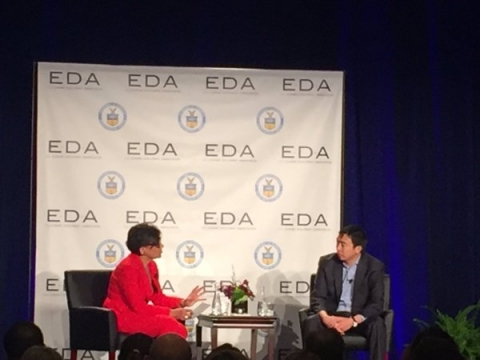Apr082016
Posted at 2:45 PM
This week, the Economic Development Administration (EDA) brought together approximately 800 regional and local economic development professionals, non-profit and private partners, and federal, state, tribal and local officials to explore issues to improving competitiveness, job growth, innovation and overall quality of life in communities at their 2016 National Conference in Washington, D.C.
The conference provided a forum for thoughtful and impactful discussions for economic development leaders to share best practices about what has been accomplished in communities and regions and explore plans for future economic growth. The conference also discussed the ongoing role of the Federal government in expanding opportunities for innovation and entrepreneurship, creating more public-private partnerships, and ensuring our communities are becoming places that enable families to succeed and thrive through the Administration’s place-based initiatives.
The Commerce Department plays a key role in supporting the innovators and job creators of tomorrow. For example, the Regional Innovation Strategies Program (RIS) competition, which is managed by the Office of Innovation and Entrepreneurship under Commerce’s Economic Development Administration, provides grants for communities and regions to help our entrepreneurs gain the tools they need to move their ideas and inventions to market. These grants invest in business incubators, startup accelerators, maker spaces, entrepreneurial training, and the establishment of locally-managed seed funds which support startups.
Secretary Pritzker reflected on her recent conversations with CEOs and other business leaders that successful economic development has truly become a team sport – requiring a holistic approach, with regional collaboration more important than ever. For example, knowing how each business sector and economic actor relates and interacts with the rest of the community is absolutely paramount. Communities can no longer evaluate or support their manufacturing assets without considering the strength and type of talent coming out of their schools and universities. Entrepreneurship development organizations can’t operate at an optimal level without tightly aligning with local investors and capital resources. She noted that because of EDA’s unique sole focus on economic development and strong leadership of numerous, coordinated multi-agency initiatives like Partnerships for Opportunity and Workforce and Economic Revitalization (POWER) initiative, the Investing in Manufacturing Communities Partnership (IMCP), and the Regional Innovation Strategies (RIS) program, the President has charged the agency with leading federal economic development integration efforts.
Focusing on the need for a skilled workforce, Secretary Pritzker spoke about the Department’s “Skills for Business” initiative and on how EDA was contributing to equipping the next generation workforce. In April 2015, EDA and the Aspen Institute launched a nationwide effort to recruit and select communities to participate a new learning exchange that builds regional partnerships to accelerate and document more effective, employer-led regional workforce initiatives across America. Seven communities, that represent a broad cross section of America ranging from NW Georgia to New York City, have now begun a 15-month intensive learning exchange designed around each region’s pursuit of job-driven talent development strategies to promote economic growth. The idea is that these communities will develop replicable methods and practices that any community can use to improve their workforce training efforts.
EDA also supports workforce development through its regular Public Works and Economic Adjustment Assistance grant programs. EDA has established “job-driven skills development” as an investment priority for its competitive grants, leading to funding for physical infrastructure improvements to training facilities such as public buildings, roads, water/sewer systems, broadband, as well as to investments in planning, research and other “soft-programs” to help communities determine their training and workforce development needs.
The conference concluded with participants agreeing that it provided a forum for thoughtful and impactful discussions about our economic future and included shared best practices and an exploration of a bold plan for future economic growth.



